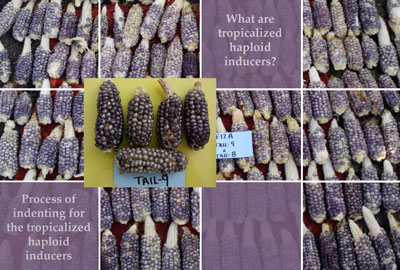 The doubled haploid (DH) technology enables rapid development of completely homozygous maize lines and offers significant opportunities for fast-track development and release of elite cultivars. Besides simplified logistics and reduced costs, use of DH lines in conjunction with molecular markers significantly improves genetic gains and breeding efficiency. DH lines also are valuable tools in marker-trait association studies, molecular marker-assisted or genomic selection-based breeding, and functional genomics.
The doubled haploid (DH) technology enables rapid development of completely homozygous maize lines and offers significant opportunities for fast-track development and release of elite cultivars. Besides simplified logistics and reduced costs, use of DH lines in conjunction with molecular markers significantly improves genetic gains and breeding efficiency. DH lines also are valuable tools in marker-trait association studies, molecular marker-assisted or genomic selection-based breeding, and functional genomics.
Generating DH lines involves four major steps: (1) In vivohaploid induction; (2) haploid seed identification using morphological markers; (3) chromosome doubling of putative haploids; and (4) generating D1 (DH) seed from D0 seedlings. In vivo haploid induction is achieved by crossing a specially developed maize genetic stock called an “inducer” (as male) with a source population (as female) from which homozygous DH lines are developed.
What are tropicalized haploid inducers?
Adoption of DH technology by public maize breeding programs and small- and mediumscale enterprise (SME) seed companies, especially in developing countries, is limited by the lack of inducers adapted to the tropical/subtropical conditions. The CIMMYT Global Maize Program, in collaboration with the Institute of Plant Breeding, Seed Science and Population Genetics of the University of Hohenheim (UHo) now has tropical haploid inducers for sharing with the interested institutions under the terms outlined below.
The tropically adapted inducer lines (TAILs) developed by CIMMYT and UHo showed high haploid induction capacity (~8-10%) and better agronomic performance than temperate inducers, in trials at two CIMMYT experiment stations in Mexico. A haploid inducer hybrid developed using these TAILs revealed heterosis for plant vigor and pollen production under tropical conditions, while maintaining similar haploid induction rates (~8-10%). CIMMYT and UHo decided to share the seed and grant authorization for use of one of the tropicalized haploid inducer lines (one of the parents of a hybrid inducer) and the hybrid inducer to interested applicants, after signing of the relevant material transfer agreement (MTA) and with restrictions to protect the intellectual property rights of both institutions for the inducer lines.
Process of indenting for the tropicalized haploid inducers
Interested applicants should send a letter of intent or an expression of interest in the tropicalized haploid inducers. CIMMYT may seek more information, if required, and will share the relevant MTA template for signing by applicants. The general guidelines to obtain inducers for research use and commercial use are as follows.
For research use by publicly-funded national agricultural research systems
Publicly-funded institutions interested in access to the haploid inducers for specific purposes (e.g., to develop DH lines for breeding programs) may send a letter of intent or expression of interest to CIMMYT. For eligible institutions, the haploid inducers will be provided free-of-charge by CIMMYT and UHo, after signing of a Research Use MTA. Commercial use of the inducers by institutions or others should be in accordance with a separate license agreement for commercial use (as given below).
For commercial use
Applicants may access the inducers for commercial use pursuant to signing of a Material Transfer and License Agreement with CIMMYT and UHo. Applicants shall pay UHo a one-time licence fee of USD 25,000 for provision of seed of two haploid inducers; these include one of the parents of a tropicalized haploid inducer hybrid and the haploid inducer hybrid itself. If applicants wish to access the other parent of the haploid inducer hybrid, an additional one-time licence fee of $10,000 will be payable to UHo.
Acknowledgments
Generous support for joint research on doubled haploids by CIMMYT and the University of Hohenheim has come from the Bill & Melinda Gates Foundation; the Howard G. Buffett Foundation; SAGARPA, the Mexican Ministry of Agriculture, Livestock, Rural Development, Fisheries and Food.; USAID (US Agency for International Development); Dr. Dr. h. c. Herrmann Eiselen and the Foundation fiat panis, Ulm, Germany; the Tiberius Services AG, Stuttgart, Germany; Vilmorin Seed Company; DTMA (Drought Tolerant Maize for Africa) project.;MAIZE CGIAR Research Program; and the International Maize Improvement Consortium (IMIC) project under MasAgro (Sustainable Modernization of Traditional Agriculture).
For further details, please contact:
Dr. BM Prasanna, Director, Global Maize Program, CIMMYT ( b.m.prasanna@cgiar.org), or
Dr. Vijay Chaikam, DH Specialist, Global Maize Program, CIMMYT ( v.chaikam@cgiar.org)
Maize Doubled Haploid Facility for Africa (3.17 MB)
The doubled haploid (DH) technology enables rapid development of completely homozygous maize lines and offers significant opportunities for fast-track development and release of elite cultivars. Besides simplified logistics and reduced costs, use of DH lines in conjunction with molecular markers significantly improves genetic gains and breeding efficiency. DH lines also are valuable tools in marker-trait association studies, molecular marker-assisted or genomic selection-based breeding, and functional genomics.
Generating DH lines involves four major steps: (1) In vivohaploid induction; (2) haploid seed identification using morphological markers; (3) chromosome doubling of putative haploids; and (4) generating D1 (DH) seed from D0 seedlings. In vivo haploid induction is achieved by crossing a specially developed maize genetic stock called an “inducer” (as male) with a source population (as female) from which homozygous DH lines are developed.
What are tropicalized haploid inducers?
Adoption of DH technology by public maize breeding programs and small- and mediumscale enterprise (SME) seed companies, especially in developing countries, is limited by the lack of inducers adapted to the tropical/subtropical conditions. The CIMMYT Global Maize Program, in collaboration with the Institute of Plant Breeding, Seed Science and Population Genetics of the University of Hohenheim (UHo) now has tropical haploid inducers for sharing with the interested institutions under the terms outlined below.
The tropically adapted inducer lines (TAILs) developed by CIMMYT and UHo showed high haploid induction capacity (~8-10%) and better agronomic performance than temperate inducers, in trials at two CIMMYT experiment stations in Mexico. A haploid inducer hybrid developed using these TAILs revealed heterosis for plant vigor and pollen production under tropical conditions, while maintaining similar haploid induction rates (~8-10%). CIMMYT and UHo decided to share the seed and grant authorization for use of one of the tropicalized haploid inducer lines (one of the parents of a hybrid inducer) and the hybrid inducer to interested applicants, after signing of the relevant material transfer agreement (MTA) and with restrictions to protect the intellectual property rights of both institutions for the inducer lines.
Process of indenting for the tropicalized haploid inducers
Interested applicants should send a letter of intent or an expression of interest in the tropicalized haploid inducers. CIMMYT may seek more information, if required, and will share the relevant MTA template for signing by applicants. The general guidelines to obtain inducers for research use and commercial use are as follows.
For research use by publicly-funded national agricultural research systems
Publicly-funded institutions interested in access to the haploid inducers for specific purposes (e.g., to develop DH lines for breeding programs) may send a letter of intent or expression of interest to CIMMYT. For eligible institutions, the haploid inducers will be provided free-of-charge by CIMMYT and UHo, after signing of a Research Use MTA. Commercial use of the inducers by institutions or others should be in accordance with a separate license agreement for commercial use (as given below).
For commercial use
Applicants may access the inducers for commercial use pursuant to signing of a Material Transfer and License Agreement with CIMMYT and UHo. Applicants shall pay UHo a one-time licence fee of USD 25,000 for provision of seed of two haploid inducers; these include one of the parents of a tropicalized haploid inducer hybrid and the haploid inducer hybrid itself. If applicants wish to access the other parent of the haploid inducer hybrid, an additional one-time licence fee of $10,000 will be payable to UHo.
Acknowledgments
Generous support for joint research on doubled haploids by CIMMYT and the University of Hohenheim has come from the Bill & Melinda Gates Foundation; the Howard G. Buffett Foundation; SAGARPA, the Mexican Ministry of Agriculture, Livestock, Rural Development, Fisheries and Food.; USAID (US Agency for International Development); Dr. Dr. h. c. Herrmann Eiselen and the Foundation fiat panis, Ulm, Germany; the Tiberius Services AG, Stuttgart, Germany; Vilmorin Seed Company; DTMA (Drought Tolerant Maize for Africa) project.;MAIZE CGIAR Research Program; and the International Maize Improvement Consortium (IMIC) project under MasAgro (Sustainable Modernization of Traditional Agriculture).
For further details, please contact:
Dr. BM Prasanna, Director, Global Maize Program, CIMMYT ( b.m.prasanna@cgiar.org), or
Dr. Vijay Chaikam, DH Specialist, Global Maize Program, CIMMYT ( v.chaikam@cgiar.org)
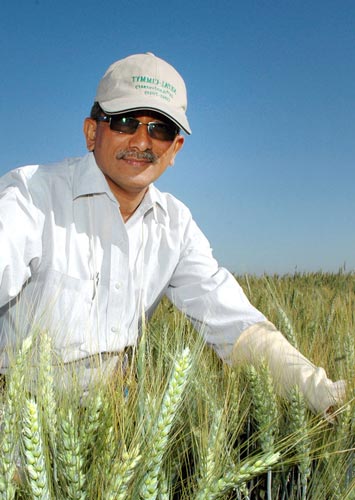 Arun Joshi, CIMMYT senior wheat breeder for South Asia, has been named Fellow of the prestigious Indian National Science Academy (INSA) at its annual meeting in Pune, India, during 27-29 December 2012. Joshi has received this award for his contribution in development of popular wheat varieties and for research in management of losses caused by spot blotch pathogen (Bipolaris sorokiniana) and heat stress. He is one of the few scientists who have not only contributed to basic and applied research in wheat, but also carried research to the field, thus directly contributing to food security and improvement of farmers’ livelihoods. “It has been a very satisfying journey for an agricultural scientist,” Joshi stated.
Arun Joshi, CIMMYT senior wheat breeder for South Asia, has been named Fellow of the prestigious Indian National Science Academy (INSA) at its annual meeting in Pune, India, during 27-29 December 2012. Joshi has received this award for his contribution in development of popular wheat varieties and for research in management of losses caused by spot blotch pathogen (Bipolaris sorokiniana) and heat stress. He is one of the few scientists who have not only contributed to basic and applied research in wheat, but also carried research to the field, thus directly contributing to food security and improvement of farmers’ livelihoods. “It has been a very satisfying journey for an agricultural scientist,” Joshi stated.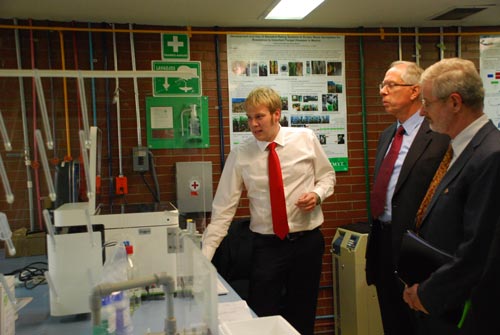 allow speedy DNA analysis for breeding. “With this new technology, we save tremendous amounts of money, time, and resources. We’re really grateful to
allow speedy DNA analysis for breeding. “With this new technology, we save tremendous amounts of money, time, and resources. We’re really grateful to 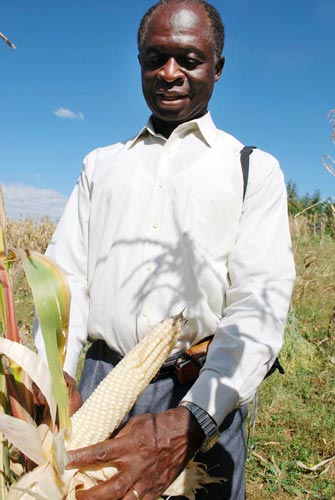 On 03 January 2013, 63-year-old Ghanaian-born maize breeder Strafford Twumasi-Afriyie succumbed to cancer, leaving a substantive legacy that includes the creation of the world’s most widely-sown quality protein maize (QPM) variety,
On 03 January 2013, 63-year-old Ghanaian-born maize breeder Strafford Twumasi-Afriyie succumbed to cancer, leaving a substantive legacy that includes the creation of the world’s most widely-sown quality protein maize (QPM) variety,  The doubled haploid (DH) technology enables rapid development of completely homozygous maize lines and offers significant opportunities for fast-track development and release of elite cultivars. Besides simplified logistics and reduced costs, use of DH lines in conjunction with molecular markers significantly improves genetic gains and breeding efficiency. DH lines also are valuable tools in marker-trait association studies, molecular marker-assisted or genomic selection-based breeding, and functional genomics.
The doubled haploid (DH) technology enables rapid development of completely homozygous maize lines and offers significant opportunities for fast-track development and release of elite cultivars. Besides simplified logistics and reduced costs, use of DH lines in conjunction with molecular markers significantly improves genetic gains and breeding efficiency. DH lines also are valuable tools in marker-trait association studies, molecular marker-assisted or genomic selection-based breeding, and functional genomics.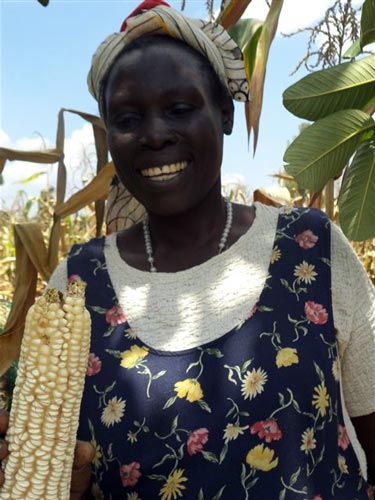 “Women are a key part of the mainstream in agriculture, yet they face formidable obstacles,” said CIMMYT gender and development specialist Vongai Kandiwa during a recent seminar in Nairobi, Kenya. Vongai was speaking on the importance of having a strategy to put men and women’s concerns and experiences at the centre of research design, implementation, monitoring, and evaluation. This involves looking at the socioeconomic settings of men and women to ensure that they benefit equally – often referred to as “gender mainstreaming.” The seminar was attended by colleagues working on various aspects of maize technology development, production, and dissemination. “By closing the gap in access to technology between men and women, we could increase productivity by 30%,” said Vongai, referring to the
“Women are a key part of the mainstream in agriculture, yet they face formidable obstacles,” said CIMMYT gender and development specialist Vongai Kandiwa during a recent seminar in Nairobi, Kenya. Vongai was speaking on the importance of having a strategy to put men and women’s concerns and experiences at the centre of research design, implementation, monitoring, and evaluation. This involves looking at the socioeconomic settings of men and women to ensure that they benefit equally – often referred to as “gender mainstreaming.” The seminar was attended by colleagues working on various aspects of maize technology development, production, and dissemination. “By closing the gap in access to technology between men and women, we could increase productivity by 30%,” said Vongai, referring to the 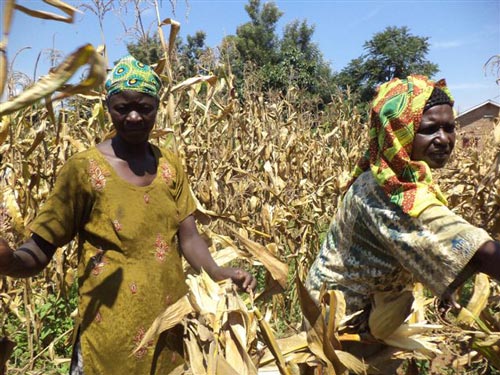 Paying particular attention to research innovations that would reduce the drudgery of farm work for women is also important, highlighted the global maize program director B.M. Prasanna. Prasanna pointed to quality protein maize (QPM) as a product developed with the nutrition needs of end users—and particularly women— in mind. QPM has increased amounts of lysine and tryptophan, important amino acids which improve nutrition. Prasanna also pointed out the promise of pesticide resistant maize that would reduce the burden of weeding for women who often provide most of the farm labor.
Paying particular attention to research innovations that would reduce the drudgery of farm work for women is also important, highlighted the global maize program director B.M. Prasanna. Prasanna pointed to quality protein maize (QPM) as a product developed with the nutrition needs of end users—and particularly women— in mind. QPM has increased amounts of lysine and tryptophan, important amino acids which improve nutrition. Prasanna also pointed out the promise of pesticide resistant maize that would reduce the burden of weeding for women who often provide most of the farm labor.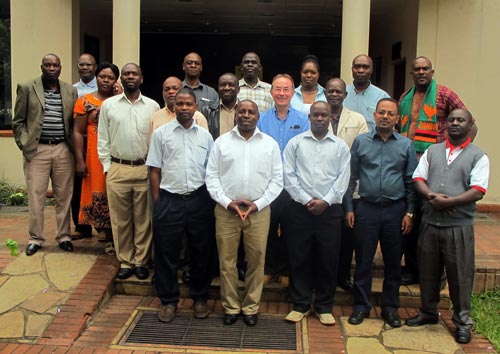
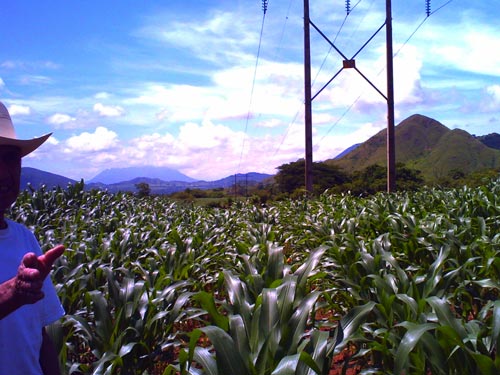
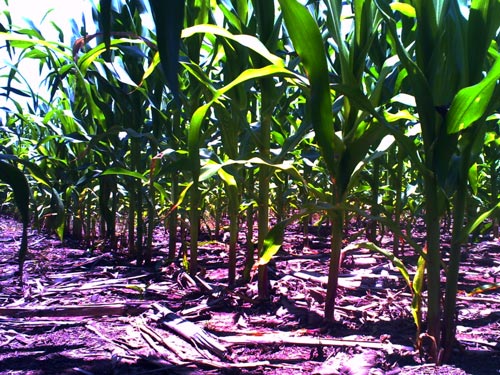
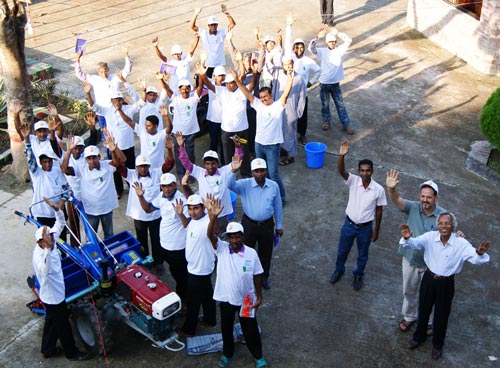 Developing public-private partnerships (PPPs) to expand conservation agriculture (CA) is one of the main goals of the
Developing public-private partnerships (PPPs) to expand conservation agriculture (CA) is one of the main goals of the 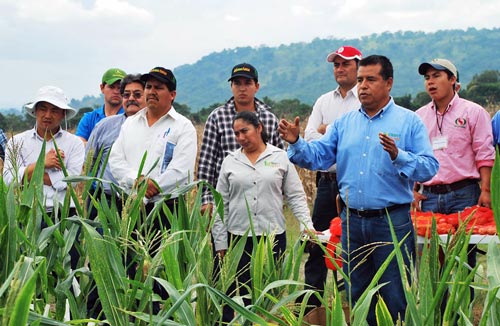 The use of doubled haploids in maize breeding was first proposed more than half a century ago and dramatically reduces the time required to produce homozygous inbred lines. Though widespread in modern maize breeding programs, the technique is little used by public programs and small- and medium-scale seed companies, especially in developing countries, partly due to its complexity.
The use of doubled haploids in maize breeding was first proposed more than half a century ago and dramatically reduces the time required to produce homozygous inbred lines. Though widespread in modern maize breeding programs, the technique is little used by public programs and small- and medium-scale seed companies, especially in developing countries, partly due to its complexity.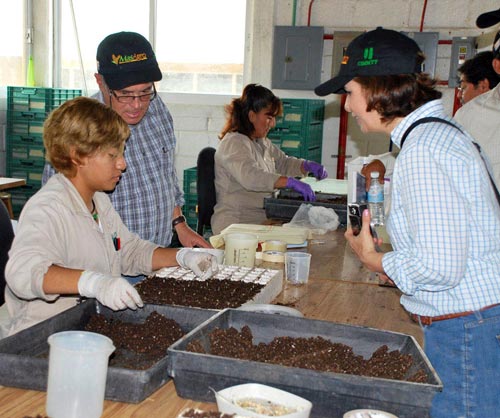 “This is a cutting-edge technology,” says Tito Clauré, Maize Program Coordinator at Bolivia’s Instituto Nacional Autónomo de Investigaciones Agropecuaria (INIAP). “We’re very happy with what we learned about double haploids, but we also attended excellent presentations on statistics, physiology, and database creation.” Clauré mentions that INIAP’s Maize Program is part of the Sustainable Modernization of Traditional Agriculture (MasAgro) project, and has received much useful germplasm from CIMMYT.
“This is a cutting-edge technology,” says Tito Clauré, Maize Program Coordinator at Bolivia’s Instituto Nacional Autónomo de Investigaciones Agropecuaria (INIAP). “We’re very happy with what we learned about double haploids, but we also attended excellent presentations on statistics, physiology, and database creation.” Clauré mentions that INIAP’s Maize Program is part of the Sustainable Modernization of Traditional Agriculture (MasAgro) project, and has received much useful germplasm from CIMMYT.